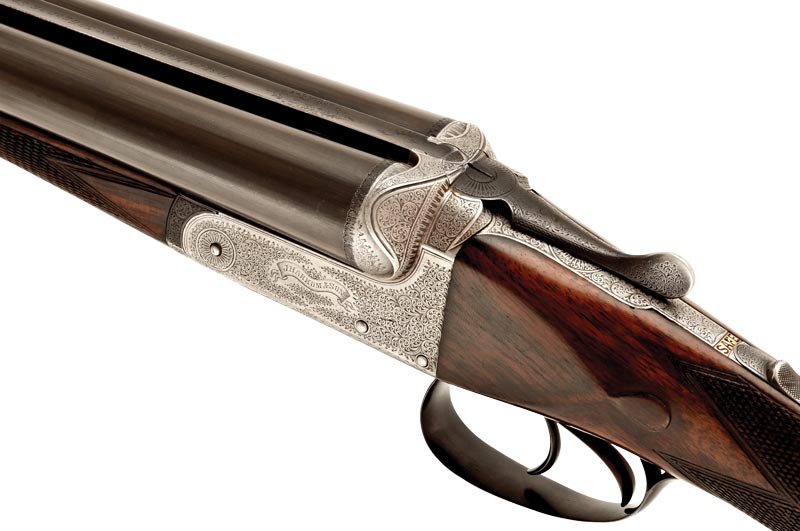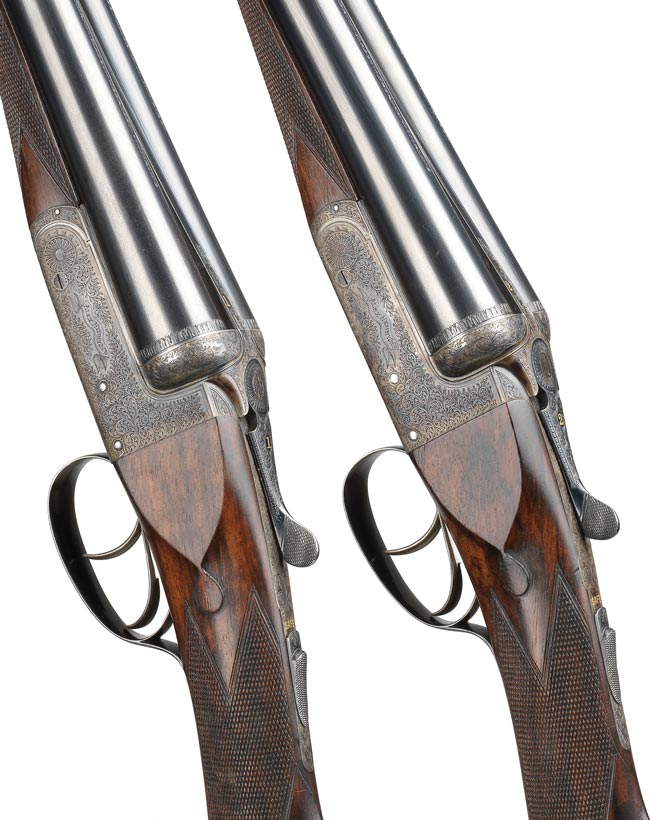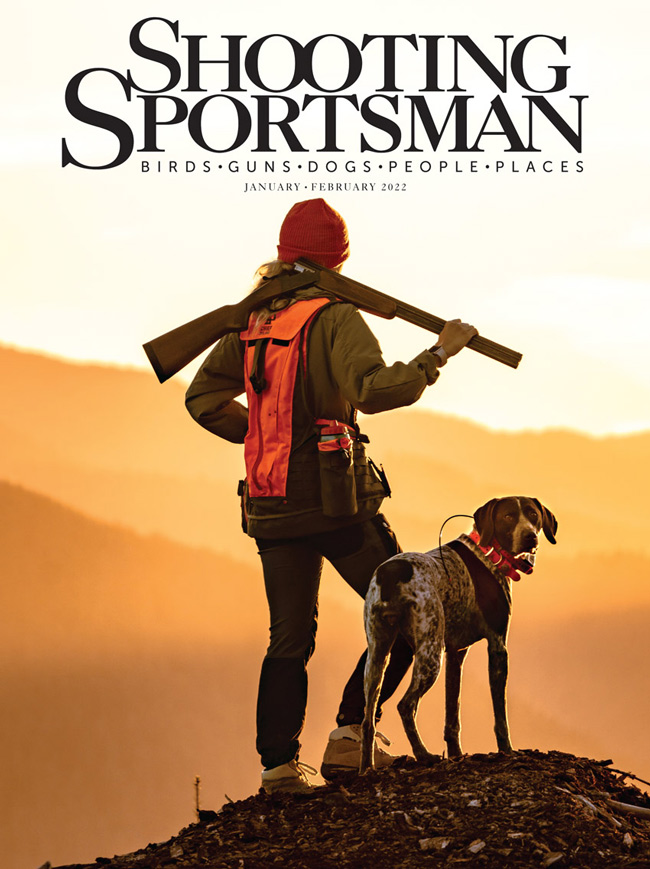The special qualities of vintage Scottish boxlocks
With the possible exception of single-malt whiskey, the Edinburgh round-action shotgun is the only luxury item made in a country universally acknowledged for fiscal prudence. Who wouldn’t want a shotgun by David McKay Brown or John Dickson & Son? But they are expensive. If a round-action is beyond your means, consider a vintage Scottish boxlock.
What I like about the Scottish round action is its discretion and restraint, the lack of unnecessary projections, the sober styling and, ultimately, the look and feel of the organic, near-cylindrical gun. The Anson & Deeley action, on the other hand, is robust, square and blocky. The appeal of each is not the same. If the round action is Norfolk worsted, then the boxlock is Harris tweed—a not-unattractive fabric but of coarser weave.

Scotland’s gunmakers knew this, and perhaps in an effort to distinguish themselves from their competition to the south, they offered what are essentially Anson & Deeley guns—but guns that boast the principal virtue of extraordinary individual aesthetic. Alex Martin, Joseph Harkom, William Horton and no one more than Dan’l Fraser lavished time and effort on what elsewhere would be considered utilitarian shotguns. The results are individual and enduring and may represent the last anomaly amongst picked-over collectibles.
Ten years ago I asked Gavin Gardiner, who has been involved with the Sotheby’s August Gleneagles sale, in Perthshire, Scotland, since 1987, why Scottish boxlocks are so special. “The Scottish makers always made an extra effort with their guns,” Gardiner said. “Whether it was their highest grade or their cheapest, they are almost always meticulously finished. The detail and refinement will be subtle, whether it is an engraving detail or a shape in the way the action is filed up, but the quality of these guns raises them above the rest. With their boxlocks—guns that were almost always sourced in the Birmingham trade—they made a real effort to make them different from all of the near-identical guns being sold around the rest of the country. Scottish boxlocks have trademark features, a trademark engraving style, an action detail, a shape here, a subtle style there; you will never mistake a Joseph Harkom for an Alexander Henry, a William Horton for a James Dalziel Dougall. They all have qualities and styles that raise them from the boxlocks south of the border. The great Arts and Crafts heritage of Scotland, especially strong in the late 19th and early 20th Centuries, was equally strong in the gunmaking of the period and resulted in some unbelievably fine gunmaking with a rare harmony of art and style that has rarely been seen since.”
Frasers were perhaps the most individual of the vintage Scottish boxlocks.
In 1875 Westley Richards unveiled the Anson & Deeley boxlock and, with the exception of the more expensive round action, it essentially ended a deluge of gun patents from Scotland and the provinces. It didn’t happen immediately, and it didn’t happen absolutely, but in the next few decades the torrent of new ideas slowed to a trickle. The provincial trade simply could not compete with what the Birmingham trade called “our best-selling gun.” The boxlock performed almost as well as competing designs such as the London sidelock and the Edinburgh round action but could be had for half the cost. In the various regions of England, gunmakers became gun retailers offering virtually identical guns differing in name only. Scottish makers, on the other hand, thought long and hard about how to make the standard boxlock distinctive.
This is not to say innovation ceased completely. Glasgow’s Alex Martin is closely linked with the ribless shotgun, in which spacers at the breech, muzzle and mid-rib are the only links between the tubes. Martin claimed the guns were “lighter, stronger and better balanced than guns of ordinary construction.” The concept was actually patented by another Scottish gunmaker, James MacNaughton, in 1899, and ironically most Martin ribless guns appear to have been built by A.A. Brown in Birmingham. Around 1902 Alex Martin merged with Alex Henry, with both makers continuing to trade under their own names.


Where Scottish boxlocks differ is largely a matter of style. Take Joseph Harkom, for example. Harkom started his business in 1837 at 15 Leopold Place, in Edinburgh. Although he had no lasting effect on shotgun development, his boxlocks were recognized for their quality. The use of fine Damascus tubes long after the introduction of fluid steel, tight scroll engraving and carved serpentine detonators suggesting a vestigial form of the percussion fence combined to create a conservative, almost retro, aesthetic. Harkom guns enjoyed a look that was both typical of the maker and unique to him.
William Horton was an Englishman who settled in Glasgow, a move he no doubt saw as advantageous to his gunmaking career. Horton boxlocks have their own distinctive appeal. The action bodies end in a fancy, or scalloped, back cut in an asymmetrical shape unique to the firm. Filing shapes in the back of boxlock guns was common enough—upgrading a prosaic action while at the same time softening the gun’s severest lines. But Horton’s scalloping was startlingly off-center and was complemented by fluted fences.
Horton’s house engraving style sprouting enigmatic tendrils of barely connected individual leaves arranged into stylized shrubbery frequently featured a half-hidden fanciful face. Peering from a mask of foliage, the face perhaps was intended to represent a green man, the legendary pagan deity of ancient Britain. It was unlike anything found in London or Birmingham. The name of the guns’ engraver, who flourished circa 1900, is unrecorded, but his style is singular and my guess is that he was a refugee from the precious-metal and jewelry trades.
No Scottish gunmaker did more than Dan’l Fraser to make the Birmingham boxlock his own. Writing in Shooting Times & Country Magazine in the spring of 1988, Glasgow-based firearms authority Geoffrey Boothroyd said: “Many and varied were the ways in which the A&D action gun could be made in a manner just that little bit different and one of the most useful dodges was to alter the shape of the back of the action from the simple straight line which we have so far seen to what the Birmingham trade called a ‘Fancy back.’ One simple way was to make the back into a slight curve as shown on the Daniel Fraser boxlock. This gun has shoulders, panels, drop points and a fancy back, and to my eyes the whole treatment is very effective.”
Frequently made with chopper-lump barrels and gold-washed internal lockwork, Frasers were perhaps the most individual of the vintage Scottish boxlocks. Attention to functional detail was reflected in the aesthetic, with the curve of the shouldered action harmoniously mirrored on a slightly larger scale by the curve at the back of the action. Carved lobate or fleur-de-lis fences coupled with bold open scroll inside a plaited Celtic border created a boxlock that transcended the prosaic and embodied a particularly fine adherence to the principles of best Scottish gunmaking.
After reminding Gavin Gardiner about his decade-old comments, I recently asked him if Scottish boxlocks are as desirable as they were a decade ago. “Good question,” he said, “and I would say that the answer is still, ‘Yes.’ In fact, if you look at how few of these lovely Scottish boxlocks have hit the market in the last decade, it just goes to show. The last ten years have been rather strange: The market for traditional ‘best’ British pairs has collapsed, and most best guns are now worth exactly what they were 30 years ago . . . . If you had bought a lovely Fraser . . . I would say that, yes, it would have appreciated in value . . . . It wouldn’t have appreciated enormously—say a rise from £1,500 to £2,000—but at least it wouldn’t have dropped 40 percent like a lot of things have.”
I asked Nick Holt of Holts Auctioneers, in England, what he thought of Scottish boxlocks. “I’d echo the sentiments already raised,” he said. “Daniel Fraser guns especially are always just that little bit more special, with their gold-washed internals and unique scalloped-backed actions. Usually chopper-lump barrels and balanced beautifully, and always cased attractively with velvet lining. You can tell by the look and the feel with these guns that not only was no expense spared, but a serious amount of love and pride went into the making of them. It’s all too rare that we get to see them!”
Fabric of coarser weave can, as we know, be stylish, more resilient and ultimately less expensive. In the hands of Scottish craftsmen, it also can be be beautiful.










Embarrassed to note this- but,am I subscribed to “Shooting Sportsman”.? I definitely want to be I find
your on-line newsletter an absolute jewel! My address is 44 Foothills Buffalo Wy. Thanks!
My understanding is most of these gunmakers catered to local clientele leading to a certain style of hunting requirements from the geographical area they served. Out of necessity the workmanship needed to server these hunters over the centuries lead to some of the best guns you can buy from a performance standpoint. Shooting Grouse is challenging enough and even more so when your doing it in freezing rain…